Posts in Category: learning
Making a new Saw Handle Instructions
 Matthew’s Blog at Workshop Heaven: Saw Handle Instructions.
Matthew’s Blog at Workshop Heaven: Saw Handle Instructions.
A great set of details on how to make an fit a saw handle. I just made one for my old beat up Disston backsaw, so I know the steps and this page is one of the best set of instructions on doing the handle.
I really like the method he used for cutting the slot, I did mine free hand and it’s ever so slightly off line.
badger
Making a new backsaw handle
When I was working down in the garage last week I noticed that my Disston backsaw handle had cracked even further. I picked it up at a antique store a while back, rusty and beaten down (but not out). I had revived the blade, and it has become a staple in the shop for mid level sawing. Tonight I made a new handle for this saw, my bench top workhorse of a saw. In three hours no less!
Christopher Schwarz might say Medium in the Coarse Medium and Fine scale, at least I think that’s what it implies as I’ve not picked up the book yet. It’s a concept I get though once I thought about, grouping tools into ones that handle the coarse, the medium and the fine.
Anyway, I got a little time tonight to work in the shop and rather than work on the project I had started last week, I decided to pick up a new project. When I get time, I tend to go with the flow, almost Zenlike if you will, although I think Zen might require less swearing and dropped tools. I picked up the backsaw to move it out of my way, and noticed the handle split again.
I picked up a random piece of scrap wood I had salvaged from the 2nd Use store, Walnut I think, and traced my old handle on the board. I sketched the busted off bottom horn by putting on of my Disston handsaws down, and making it fit. Then I tweaked it a little to make the whole think look right.
To make the cut outs and make the inner curves I tried a trick I read on a blog somewhere, and used a number 12 and number 16 auger bit to make the really tight curves of the inner handle and under the horns in the back of the handle. I cranked these up in my brace and bit (is it just a brace?) and did one side till the lead screw poked out the other side, and then flipped it over to get a clean hole with no tear out.
Then I cut out whole thing using a coping saw mostly with some straight cuts with my crosscut or dovetail saw. (Coarse and Fine, but really it was whatever worked and was handy.) I tried to stay as close to my pencil lines as I could. The auger holes were a HUGE help and really made this much easier. I highly recommend this approach when making a saw handle like this.
Then it was time for lots of file work. This is what took most of the three hours, mostly with a coarse toothed rasp that had a round and a flat side. I kept referring back to the original handle as to where to shape, and lots of test fitting to my hand and adjusting and filing, etc. I broke a pretty fair sweat on this part, but it was fun to have it becomes slowly become more and more comfortable in my hand. I tuned it up with a finer rasp, and finally some 120 grit sand paper to make it smooth. I didn’t go any smoother, because it was getting late, and it felt pretty good in my hand already.
Once it felt right, I was really on a groove and didn’t take any more pictures of the rest of the build. I’ll do my best to describe the next steps. To make the slot for the blade I free-handed the line down the middle carefully. Checking it against the old handle a lit. Then I started the cut with my dovetail saw very slowly. Once I had a good line going, I grabbed the backsaw blade itself, and used it carefully with out the handle to make the rest of the cut. I took my time, one cut at a stroke, and checked my line frequently. It took a while, but this had to be right.
Then I took my smallest chisel, and cut out the notch at the top for the backsaw spine. This I also took very carefully, and carved it as best I could. Turns out I was a little too cautious here, as I had to go back to the notch twice to get the blade to fit with the screws lined up.
Once I had it close, I needed to drill the holes for the screws, and I had to use a powered tool (my beloved cordless drill) since I did not have the right sized auger bits. This is the only non human powered tool used in this whole build. I drilled the holes by clamping the old and new handle together, and drilling through the old holes as a guide. Then I fit the screws to the handle with a variety of twist drill bit sizes. This is where I had to tweak the handle quite a bit, to get this to all line up and fit right. The slot for the spine was too shallow, so it had to be adjusted.
Once it all lined up, I screwed it together (it was getting late) and put a coat of walnut oil on the handle as a finish. I didn’t sink the screw heads yet, and I can feel a couple rough spots that will need to be tweaked, but over all it felt really good in my hand, and it was really nice to start something and finish it in the same night.
I feel like I’ve passed some hand tool rite of passage here, and I’ve read a lot of blogs online and sooner or later they all seem to make this step. I was also surprised at how EASY this was. I had been intimidated by the concept, but for some reason tonight it was a simple thing for me. See, rite of passage. It’s a Zen thing I think, once you are at a certain level or something.
Anyway, I need to get to bed, but I’m pretty pleased with tonight.
Badger
The simplicity of a planing stop
Tonight I discovered something, I’m sure the experienced hand tool wood workers out there already knew.
The simple ease of the planing stop.
A proper height bench, a good piece of wood and a sharp plane really helps, but the simple ease of a planing stop is pretty cool. Before my instincts would have been to clamp the crap out of it, but I tried something new tonight. I clamped a scrap piece of pine to the end of the bench, laid the wood down resting against the stop with no other clamping, and started planing. And it worked, like a dream. I even did the edge planing with nothing additional. Pretty neat.
The board in the background is what the board on the bench used to look like. The ECE Jack plane worked great for taking off that ugly finish, and flattening the edges. I even took an edge down from my first attempt at ripping with no problems (it needed a LOT of work.)
More later on the project I’m prepping the wood for.
Badger
Italian carpenters tools from 1574
Noah’s Sacrifice by BASSANO, Jacopo.
Check the link, it shows a painting by Jacopo Bassano, an Italian painter, depicting a scene of Noah, presumably building an Ark or something I can’t quite tell (and don’t really care, the rest of the scene has my whole attention). In the lower right corner there are a bunch of tools that the workmen are using scattered about, as well as a simple and more elaborate chest.
I see the following:
- Bowsaw
- Plane (in the roman style it looks like)
- Hammer
- Several Adzes
- Axe
- Level (A-Frame style)
- T-handled Auger and Gimlets
- Pick
- Hammer
- Compass/Divider
- Pliers/Pincher of some sort
The planes are of special interest, as they are clearly the style of body found in Pompeii and other Roman finds. Only later than I’m used to seeing. Also it’s interesting because the iron is set so far back in the body.
Very interesting. I found the picture through a reference to dovetails in one of the chests, which I can’t make out in the picture.
UPDATE:
I found another example of this type of plane body in another Italian painting in a similar time frame:
The clip above is a close up of painting by Tintoretto of the Annunciation which has some tools visible. I tried to clean up the dark portion of the painting a little for clarity, but you can clearly see the body and iron set well back in the body. It’s deliberate, as you can see the rounding of the plane body heel in this close up. It makes me wonder how you’d use such a plane? Is it a push or pull? Hrm…
Badger
Dovetailed Box – Practice
So, why on earth do I get those rare moments of shop time during some of the hottest days of the year so far? But, who am I to complain. It wasn’t too hot in the garage, just a bit warm, so I got some more dovetailing done. I managed not to screw up three more corners, and even got something that is starting to resemble a box together!
Well, at least four sides of a box. I had to trim a few pins again, and split one tail a little because because I didn’t trim enough. Man, the compression of pine can really fool you. In a comment on my last post, Jay suggested Poplar. After today, I think he might be on to something, so I might head on down to big box Home Depot and get some.
I made lots and lots of little mistakes, trying to saw off a pin, forgetting that I should use a coping saw when cutting out the pins, don’t force it too much, mark your waste, and actually LOOK for the X’s. I am starting to remember to look for the cabinet maker marks to keep alignment, so that’s progress. And, really, I am a fair amount pleased with the dovetails. Yeah they are ugly, and stand far to proud (better marking with the gauge next time), but it actually came together.
It is gluing up now, and tonight I hope to actually be able to nail a bottom to it to make it a real box. I might even scrounge up some hinges and put a lid on it. I’ve been wanting something to put my carving tools it. Right now I have some small palm carving tools that I use for wood block carving. I’ve been storing them in a plastic tub. This would be so much better I think.
badger
Practice Dovetails
One thing I love about hand tool work is that I can hear, and breathe while do it. Much less dust, much less noise. I can hear my music, and enjoy it while working up a sweat and breathing not clouds of dust, or struggling to breathe in a dust mask. It’s a very nice side benefit, it really is.
Tonight I started a new set of dovetails for a shop box. I got discouraged after my last set where I screwed up which direction I was going, and ruined a perfectly good box. This is intended to be a quick project (I should insert some kind of joke here about time, but let us just move on shall we?) to practice dovetails, and work out some hand tool techniques.
It was very quickly apparent that I hadn’t been down there in a while, as the skills were rusty, but I did manage to not screw up irreversibly tonight, and got one corner done. I had to trim the tails to fit more than I would have liked, and I really really need to learn to pay attention to my face marks. I nearly botched it again with the wrong face out. It would have been an easy fix, but still it’s something I’m not used to looking for.
I did fine tune somewhat the little dovetail saw I picked up. My attempt at sharpening is just that, an attempt, but it doesn’t cut too badly. It was binding a lot, so I think it needs some set added to the teeth, which will be interesting at that size. But, a little bit of beeswax on the sides fixed most of the binding, and I think I need to touch up the teeth with a little more care.
Also, you can see the Vise in action here. I am actually VERY pleased with the vise set up, it is night and day from what I was doing before, and makes quite a difference in how I did tonight. I was able to gang-cut two tails, and cut one set of pins fairly quickly with this MacGyver setup. I wish it was a bit more secure, but I would need a stronger bench top than the 3/4″ MDF top this bench has. But it worked for my purposes. Plus I was able to remove it, use my bench hook, and then put it back on in a matter of minutes.
I need the practice, that much is clear, but I wasn’t totally adrift down there, so that was good. I hope to actually finish this box (fingers crossed) before my big San Diego trip, but I am not going to make any promises I probably can’t keep. We shall see.
Badger
Solving a problem with new thinking…
Check the blog post above. It’s a great example of thinking of a problem in a different light, and solving it differently. I always thought that frame saws usually required pins like these which I actually just purchased recently, or making your own out of bolts with a hack saw.
However, this solution is much more elegant and cheaper for casual use. I could even see mounting these in a handle with a cross pin, or not. For a bang together saw frame it’s just fine.
I love to just wander through hardware stores from time to time, just see what’s there. There is always some little thing sitting dusty on a shelf somewhere that is interesting or neat.
Badger
Twin Screw Vise
Did some cleaning and organizing tonight. I got about a half hour to play, but then it was the kiddo’s bed time.
I did get enough time to accomplish a few things.
1. Clean and oil the long jointer plane I picked up last month. Pictures later after I clean up the blade and give it a try.
2. Give myself a nasty sliver, which required major excavation to get most of it. Note to self: go buy better tweezers specifically for splinters. We couldn’t get all of it. Ouchie. The band aid is also making it hard to type. I suffer, I tell you SUFFER!
3. Cleared enough space to try out something I read about on the internet about historical twin screw vises. I snagged a “book press” at a PNTC gathering a month or so back. quick as you like, I have a twin screw vise.
Thank you Chris Schwarz. You rock.
badger
Book Review: The Joiner and Cabinet Maker
Book review time!
As I promised a few posts back, I’m going to write up my thoughts on this book and share them with you all.
The book is “The Joiner and the Cabinet Maker” by Moskowitz and Schwartz. It’s available here at Lost Art Press for $29 by itself, or $34 with a companion DVD. Which was the version I got, and it was worth it. My first copy got lost in the mail somehow, and the wonderful people there sent me a copy again, first class customer service there.
This book is different, that’s what makes it hard to summarize or review I think. It’s not the normal woodworking or history book, it’s both and also more than that. It’s a history book, a how to book, and an inspiring story all rolled into one. It’s very readable, hard to put down, and makes we want to work on my hand tool all at once.
The first part of the book is some context for the story, and the history behind it.
The second part is a story following a young apprentice as he learns the craft of joinery.
The third part documents the three projects discussed in the story, and lays out practical steps and context for the tools and techniques.
The context provided is the best part. It’s like you’ve got a master craftsman sitting there reading with you, and pointing out parts that are unclear based on the drift of language over time or providing details to make something a bit more concrete. Joel Moskowitz covers a lot of background, and practical stuff in the footnotes sprinkled all through the story text. It adds so much to learning part, helps with context and makes it all the more useful.
The story itself is a bit quaint, but the knowledge presented is unique, since most of things being discussed are rarely written down from that time, and represents a chance for a modern person to take a few lessons in a long gone joiners shop. And then, Christopher Schwartz translates the actual projects for us, helping us bridge the gap in ways that make sense.
I read it cover to cover, and was sad when it was done. I want more books like this, and I don’t think they exist.
I highly recommend that any aspiring hand tool woodworker should read this book. It’s worth it.
Badger
*corrected who wrote the footnotes.
Great post on designing a workbench…
I heartily recommend checking out this post on designing a workbench over at the Logan Cabinet Shop. He goes through a whole host of things that help in designing your own bench to meet your needs.
It’s on par with Chris Schwartz’s work in the book I mentioned a few posts ago.
Badger


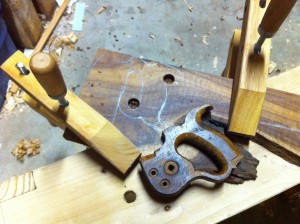

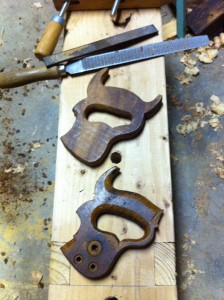




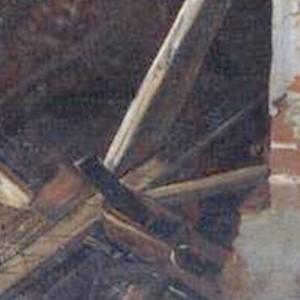

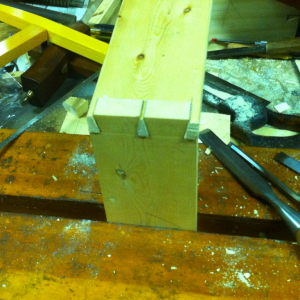

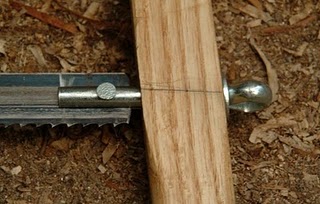


You must be logged in to post a comment.